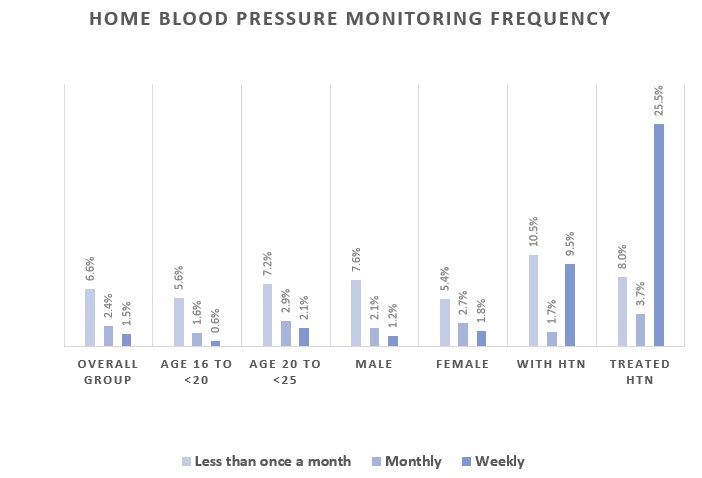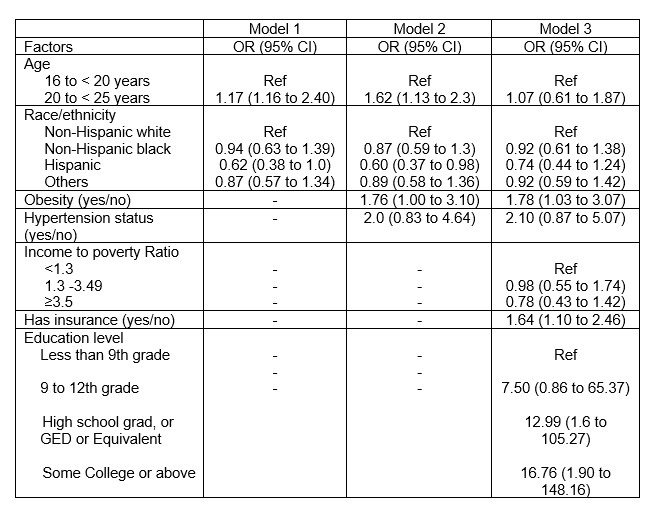Hypertension
Session: Hypertension
69 - Home Blood Pressure Monitoring in Adolescents and Young Adults, NHANES 2009-2014
Sunday, May 5, 2024
3:30 PM - 6:00 PM ET
Poster Number: 69
Publication Number: 69.1729
Publication Number: 69.1729
- RB
Rushelle Byfield, MD (she/her/hers)
Assistant Professor
NewYork-Presbyterian Morgan Stanley Children's Hospital
New York, New York, United States
Presenting Author(s)
Background: Hypertension (HTN) in childhood and young adulthood is associated with increased risk of cardiovascular disease, a leading cause of mortality worldwide. Home blood pressure (BP) monitoring (HBPM) is a critical adjunct for both the diagnosis and management of HTN. Despite this, previous studies reveal that HBPM is an underutilized tool; only 38% of US adults with HTN and 45% of those with treated HTN perform HBPM at least monthly. Little is known about the prevalence and frequency of HBPM and what sociodemographic factors predict the use of HBPM among adolescents and young adults.
Objective: To determine the prevalence and frequency of HBPM in adolescents and young adults and if sociodemographic factors are associated with frequency of HBPM performance.
Design/Methods: Using data from 2009-2014 National Health and Nutrition Examination Surveys (NHANES) we examined self-reported HBPM in adolescents and young adults aged 16 to 25 years. Participants were asked to report “How often did you check your BP at home in the last 12 months?” Frequency of HBPM was defined as none, less than once a month, monthly, or weekly based on survey response. Results were weighted by population sampling and stratified by age group (16 to < 20 vs. 20 to < 25 years), sex, race, and ethnicity, HTN status (defined by measured BP≥140/90 or self-reported diagnosis), and antihypertensive medication use.
Results: A total of 2,596 NHANES participants had complete data for inclusion in the analysis. 237 (9.1%) reported HBPM in the prior 12 months. Less than monthly, monthly, and weekly HBPM frequency was 6.6%, 2.4% and 1.5% respectively. Among the groups examined, monthly and weekly HBPM frequency was highest in those with HTN (1.7%, 9.5%) and those taking antihypertensive medication (3.7%, 25.5%). In models adjusting for clinical and sociodemographic factors, HBPM performance in the past 12 months was associated with having insurance [OR 1.64 (95% CI: 1.10 to 2.46)], higher education level [OR 12.99 (95% CI: 1.6 to 105.27), and obesity [OR 1.78 (95% CI: 1.03 to 3.07)].
Conclusion(s): HBPM is performed in a small proportion of adolescents and young adults between ages 16 to < 25 as well as those with HTN. Factors associated with HBPM use were obesity, having insurance, and higher education level. These results highlight the need for focused efforts on increasing HBPM among adolescents and young adults. Further studies should also examine the role of both provider counseling and patient perception of HBPM.


.jpg)
